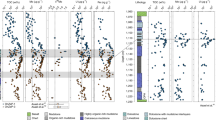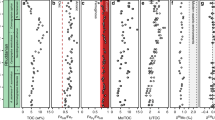Burgess, S. D., Bowring, S. A. & Shen, S. Z. High-precision timeline for Earth’s most severe extinction. Proc. Natl. Acad. Sci. USA 111, 3316–3321 (2014).
Article
CAS
Google Scholar
Fan, J. X. et al. A high-resolution summary of Cambrian to Early Triassic marine invertebrate biodiversity. Science 367, 272–277 (2020).
Article
CAS
Google Scholar
Stanley, S. M. Estimates of the magnitudes of major marine mass extinctions in earth history. Proc. Natl. Acad. Sci. USA 113, e6325–E6334 (2016).
Article
CAS
Google Scholar
Fang, Z. et al. Ocean redox changes from the latest Permian to Early Triassic recorded by chromium isotopes. Earth Planet. Sci. Lett. 570, 117050 (2021).
Article
CAS
Google Scholar
Shen, Y. et al. Multiple S-isotopic evidence for episodic shoaling of anoxic water during Late Permian mass extinction. Nat. Commun. 2, 1–5 (2011).
Article
Google Scholar
Zhang, F. et al. Congruent Permian-Triassic δ238U records at Panthalassic and Tethyan sites: Confirmation of global-oceanic anoxia and validation of the U-isotope paleoredox proxy. Geology 46, 327–330 (2018).
Article
CAS
Google Scholar
Newby, S. M., Owens, J. D., Schoepfer, S. D. & Algeo, T. J. Transient ocean oxygenation at end-Permian mass extinction onset shown by thallium isotopes. Nat. Geosci. 14, 678–683 (2021).
Article
CAS
Google Scholar
Cao, C. et al. Biogeochemical evidence for euxinic oceans and ecological disturbance presaging the end-Permian mass extinction event. Earth Planet. Sci. Lett. 281, 188–201 (2009).
Article
CAS
Google Scholar
Grice, K. et al. Photic zone euxinia during the Permian-Triassic superanoxic event. Science 307, 706–709 (2005).
Article
CAS
Google Scholar
**ang, L. et al. Oceanic redox evolution around the end-Permian mass extinction at Meishan, South China. Palaeogeogr. Palaeoclimatol. Palaeoecol. 544, 109626 (2020).
Article
Google Scholar
Elrick, M. et al. Global-ocean redox variation during the middle-late Permian through Early Triassic based on uranium isotope and Th/U trends of marine carbonates. Geology 45, 163–166 (2017).
Article
CAS
Google Scholar
Jiang, Z. et al. The magnetic and color reflectance properties of hematite: From Earth to Mars. Rev. Geophys. 60 https://doi.org/10.1029/2020rg000698 (2022).
O’Reilly, W. Rock and Mineral Magnetism. (Springer, Boston, MA., 1984).
Lepre, C. J. & Olsen, P. E. Hematite reconstruction of Late Triassic hydroclimate over the Colorado Plateau. Proc. Natl. Acad. Sci. 118, e2004343118 (2021).
Article
CAS
Google Scholar
Deng, C., Shaw, J., Liu, Q., Pan, Y. & Zhu, R. Mineral magnetic variation of the **gbian loess/paleosol sequence in the northern Loess Plateau of China: Implications for Quaternary development of Asian aridification and cooling. Earth Planet. Sci. Lett. 241, 248–259 (2006).
Article
CAS
Google Scholar
Slotznick, S. P., Swanson-Hysell, N. L. & Sperling, E. A. Oxygenated Mesoproterozoic lake revealed through magnetic mineralogy. Proc. Natl. Acad. Sci. USA 115, 12938–12943 (2018).
Article
CAS
Google Scholar
Larrasoaña, J. C., Roberts, A. P., Stoner, J. S., Richter, C. & Wehausen, R. A new proxy for bottom-water ventilation in the eastern Mediterranean based on diagenetically controlled magnetic properties of sapropel-bearing sediments. Palaeogeogr. Palaeoclimatol. Palaeoecol. 190, 221–242 (2003).
Article
Google Scholar
Wu, L., Kravchinsky, V. A. & Potter, D. K. Apparent polar wander paths of the major Chinese blocks since the Late Paleozoic: Toward restoring the amalgamation history of east Eurasia. Earth Sci. Rev. 171, 492–519 (2017).
Article
Google Scholar
Shen, S. Z. et al. Calibrating the end-Permian mass extinction. Science 334, 1367–1372 (2011).
Article
CAS
Google Scholar
Liu, S. A. et al. Zinc isotope evidence for intensive magmatism immediately before the end-Permian mass extinction. Geology 45, 343–346 (2017).
Article
CAS
Google Scholar
Sun, H. et al. Rapid enhancement of chemical weathering recorded by extremely light seawater lithium isotopes at the Permian-Triassic boundary. Proc. Natl. Acad. Sci. USA 115, 3782–3787 (2018).
Article
CAS
Google Scholar
Wu, H. et al. Time-calibrated Milankovitch cycles for the late Permian. Nat. Commun. 4, 2452 (2013).
Article
Google Scholar
Yuan, D. X. et al. Revised conodont-based integrated high-resolution timescale for the Changhsingian Stage and end-Permian extinction interval at the Meishan sections, South China. Lithos 204, 220–245 (2014).
Article
CAS
Google Scholar
Zhang, M. et al. Magnetostratigraphy across the end-Permian mass extinction event from the Meishan sections, southeastern China. Geology 49, 1289–1294 (2021).
Article
CAS
Google Scholar
Roberts, A. P., Cui, Y. & Verosub, K. L. Wasp‐waisted hysteresis loops: Mineral magnetic characteristics and discrimination of components in mixed magnetic systems. J. Geophys. Res.: Solid Earth 100, 17909–17924 (1995).
Article
Google Scholar
Robertson, D. J. & France, D. E. Discrimination of remanence-carrying minerals in mixtures, using isothermal remanent magnetization acquisition curves. Phys. Earth Planet. Inter. 82, 223–234 (1994).
Article
CAS
Google Scholar
Kruiver, P. P., Dekkers, M. J. & Heslop, D. Quantification of magnetic coercivity components by the analysis of acquisition curves of isothermal remanent magnetisation. Earth Planet. Sci. Lett. 189, 269–276 (2001).
Article
CAS
Google Scholar
Bloemendal, J., King, J., Hall, F. & Doh, S. J. Rock magnetism of Late Neogene and Pleistocene deep‐sea sediments: Relationship to sediment source, diagenetic processes, and sediment lithology. J. Geophys. Res.: Solid Earth 97, 4361–4375 (1992).
Article
Google Scholar
Tadić, M. et al. Synthesis, morphology, microstructure and magnetic properties of hematite submicron particles. J. Alloys Compd. 509, 7639–7644 (2011).
Article
Google Scholar
Kosmulski, M., Durand-Vidal, S., Mączka, E. & Rosenholm, J. B. Morphology of synthetic goethite particles. J. Colloid Interface Sci. 271, 261–269 (2004).
Article
CAS
Google Scholar
Dunlop, D. J. & Özdemir, Ö. Rock Magnetism: Fundamentals and Frontiers. (Cambridge University Press, 1997).
Song, H. et al. Geochemical evidence from bio-apatite for multiple oceanic anoxic events during Permian–Triassic transition and the link with end-Permian extinction and recovery. Earth Planet. Sci. Lett. 353-354, 12–21 (2012).
Article
CAS
Google Scholar
Roberts, A. P. Magnetic mineral diagenesis. Earth Sci. Rev. 151, 1–47 (2015).
Article
CAS
Google Scholar
Algeo, T. J. & Twitchett, R. J. Anomalous Early Triassic sediment fluxes due to elevated weathering rates and their biological consequences. Geology 38, 1023–1026 (2010).
Article
Google Scholar
Song, H. et al. Integrated Sr isotope variations and global environmental changes through the Late Permian to early Late Triassic. Earth Planet. Sci. Lett. 424, 140–147 (2015).
Article
CAS
Google Scholar
Burgess, S. D. & Bowring, S. A. High-precision geochronology confirms voluminous magmatism before, during, and after Earth’s most severe extinction. Sci. Adv. 1, e1500470 (2015).
Article
Google Scholar
Shen, S. Z. et al. A sudden end-Permian mass extinction in South China. Geol. Soc. Am. Bull. 131, 205–223 (2019).
Article
CAS
Google Scholar
**, Y. et al. The Global Boundary Stratotype Section and Point (GSSP) for the base of Changhsingian Stage (Upper Permian). Episodes 29, 175–182 (2006).
Article
Google Scholar
Zhang, K. & Shields, G. A. Sedimentary Ce anomalies: Secular change and implications for paleoenvironmental evolution. Earth Sci. Rev. 229, 104015 (2022).
Article
CAS
Google Scholar
Liu, X.-M., Hardisty, D. S., Lyons, T. W. & Swart, P. K. Evaluating the fidelity of the cerium paleoredox tracer during variable carbonate diagenesis on the Great Bahamas Bank. Geochim. Cosmochim. Acta 248, 25–42 (2019).
Article
CAS
Google Scholar
Banner, J. L., Hanson, G. N. & Meyers, W. J. Rare earth element and Nd isotopic variations in regionally extensive dolomites from the Burlington-Keokuk Formation (Mississippian); implications for REE mobility during carbonate diagenesis. J. Sediment. Res. 58, 415–432 (1988).
CAS
Google Scholar
Liu, X.-M. et al. A persistently low level of atmospheric oxygen in Earth’s middle age. Nat. Commun. 12 https://doi.org/10.1038/s41467-020-20484-7 (2021).
Bolhar, R. & Van Kranendonk, M. J. A non-marine depositional setting for the northern Fortescue Group, Pilbara Craton, inferred from trace element geochemistry of stromatolitic carbonates. Precambrian Res 155, 229–250 (2007).
Article
CAS
Google Scholar
Frimmel, H. E. Trace element distribution in Neoproterozoic carbonates as palaeoenvironmental indicator. Chem. Geol. 258, 338–353 (2009).
Article
CAS
Google Scholar
Tostevin, R. et al. Effective use of cerium anomalies as a redox proxy in carbonate-dominated marine settings. Chem. Geol. 438, 146–162 (2016).
Article
CAS
Google Scholar
Li, M. et al. Nickel isotopes link Siberian Traps aerosol particles to the end-Permian mass extinction. Nat. Commun. 12, 1–7 (2021).
Google Scholar
**, Y. G. et al. Pattern of marine mass extinction near the Permian-Triassic boundary in South China. Science 289, 432–436 (2000).
Article
CAS
Google Scholar
Wang, Y. et al. Quantifying the process and abruptness of the end-Permian mass extinction. Paleobiology 40, 113–129 (2014).
Article
Google Scholar
Wei, H., Tang, Z., Yan, D., Wang, J. & Roberts, A. P. Guadalupian (Middle Permian) ocean redox evolution in South China and its implications for mass extinction. Chem. Geol. 530, 119318 (2019).
Article
CAS
Google Scholar
Fielding, C. R. et al. Age and pattern of the southern high-latitude continental end-Permian extinction constrained by multiproxy analysis. Nat. Commun. 10, 1–12 (2019).
Article
Google Scholar
Gastaldo, R. A. et al. The base of the Lystrosaurus Assemblage Zone, Karoo Basin, predates the end-Permian marine extinction. Nat. Commun. 11, 1–8 (2020).
Article
Google Scholar
Chu, D. et al. Metal-induced stress in survivor plants following the end-Permian collapse of land ecosystems. Geology 49, 657–661 (2021).
Article
CAS
Google Scholar
Fielding, C. R. et al. Sedimentology of the continental end-Permian extinction event in the Sydney Basin, eastern Australia. Sedimentology 68, 30-62 (2021).
Chapman, T., Milan, L. A., Metcalfe, I., Blevin, P. L. & Crowley, J. Pulses in silicic arc magmatism initiate end-Permian climate instability and extinction. Nat. Geosci. 15, 411–416 (2022).
Article
CAS
Google Scholar
Grasby, S. E., Sanei, H. & Beauchamp, B. Catastrophic dispersion of coal fly ash into oceans during the latest Permian extinction. Nat. Geosci. 4, 104–107 (2011).
Article
CAS
Google Scholar
Sobolev, S. V. et al. Linking mantle plumes, large igneous provinces and environmental catastrophes. Nature 477, 312–316 (2011).
Article
CAS
Google Scholar
Zhang, H. et al. Felsic volcanism as a factor driving the end-Permian mass extinction. Sci. Adv. 7, eabh1390 (2021).
Article
CAS
Google Scholar
Shen, J., Zhang, Y. G., Yang, H., **e, S. & Pearson, A. Early and late phases of the Permian–Triassic mass extinction marked by different atmospheric CO2 regimes. Nat. Geosci. 15, 1–6 (2022).
Article
Google Scholar
Wu, Y. et al. Six-fold increase of atmospheric pCO2 during the Permian–Triassic mass extinction. Nat. Commun. 12, 2137 (2021).
Article
CAS
Google Scholar
Penn, J. L., Deutsch, C., Payne, J. L. & Sperling, E. A. Temperature-dependent hypoxia explains biogeography and severity of end-Permian marine mass extinction. Science 362, eaat1327 (2018).
Article
Google Scholar
Schobben, M. et al. A nutrient control on marine anoxia during the end-Permian mass extinction. Nat. Geosci. 13, 640–646 (2020).
Article
CAS
Google Scholar
Haslett, J. & Parnell, A. A simple monotone process with application to radiocarbon‐dated depth chronologies.J. Royal Stat. Soc. Series C. Appl Stat 57, 399–418 (2008).
Article
Google Scholar
Parnell, A. C., Haslett, J., Allen, J. R. M., Buck, C. E. & Huntley, B. A flexible approach to assessing synchroneity of past events using Bayesian reconstructions of sedimentation history. Quat. Sci. Rev. 27, 1872–1885 (2008).
Article
Google Scholar
Strehlau, J. H., Hegner, L. A., Strauss, B. E., Feinberg, J. M. & Penn, R. L. Simple and efficient separation of magnetic minerals from speleothems and other carbonates. J. Sediment. Res. 84, 1096–1106 (2014).
Article
CAS
Google Scholar
Jenner, G. A., Longerich, H. P., Jackson, S. E. & Fryer, B. J. ICP-MS — A powerful tool for high-precision trace-element analysis in Earth sciences: Evidence from analysis of selected U.S.G.S. reference samples. Chem. Geol. 83, 133–148 (1990).
Article
CAS
Google Scholar
Taylor, S. R. & McLennan, S. M. The continental crust: Its composition and evolution. 1–312 (Blackwell Scientific Pub.,Palo Alto, CA, 1985).
Pourmand, A., Dauphas, N. & Ireland, T. J. A novel extraction chromatography and MC-ICP-MS technique for rapid analysis of REE, Sc and Y: Revising CI-chondrite and Post-Archean Australian Shale (PAAS) abundances. Chem. Geol. 291, 38–54 (2012).
Article
CAS
Google Scholar
Lécuyer, C. et al. δ18O and REE contents of phosphatic brachiopods: a comparison between modern and lower Paleozoic populations. Geochim. Cosmochim. Acta 62, 2429–2436 (1998).
Article
Google Scholar
Blakey, R.C. Triassic global paleogeographic map (250 Ma). Global Paleogeography and Tectonics in Deep Time Series (Deep Time Maps™,2020). https://deeptimemaps.com/map-lists-thumbnails/global-paleogeography-and-tectonics-in-deep-time/.








